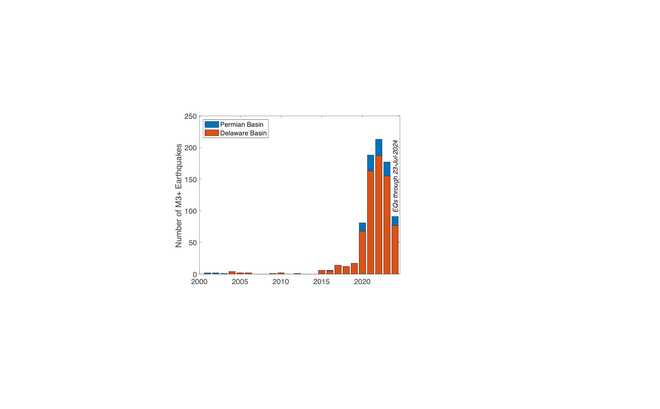Rash of earthquakes blamed on oil production, including a magnitude 4.9 in Texas
Three earthquakes that struck west Texas on Monday – including a magnitude 4.9 temblor – are all linked to local oil production.
Three quakes were recorded Monday night in Scurry County, Texas. The magnitude 4.9 earthquake occurred at 10:38 p.m. local time and tied for the eighth-strongest earthquake in the state’s history.
Two other earthquakes followed shortly after in the same general area, including a 4.4 magnitude earthquake at about 10:46 p.m. and a 3.1 magnitude earthquake at 11:56 p.m.
“We can say with confidence that these are related to oil and gas extractions,” said Justin Rubinstein, a geophysicist with the U.S. Geological Survey in Menlo Park, California.
The area is sparsely populated and no injuries or damage were reported.
'It could happen tomorrow':Experts know disaster upon disaster looms for West Coast
Until Monday’s earthquake, the largest earthquake known to have been induced by enhanced oil recovery was a magnitude 4.6. in the Cogdell Oil Field area, near Snyder, Texas, according to USGS research.
Texas is not considered a naturally seismically active area and in general had a low rate of earthquakes until the advent of new oil production methods.
Texas earthquakes linked to enhanced oil recovery
Temblors linked to oil and natural gas extraction are called induced earthquakes.
The Texas area near Monday’s tremors has seen a significant increase in earthquake activity since 2019, which USGS scientists believe is linked to enhanced recovery techniques used in played-out oil fields to economically extract the most difficult-to-get oil and natural gas.

“Say you have 100 wells in one oil and gas reservoir,” said Rubinstein. “You take half of the field out of production, inject a bunch of water into those wells and the water pushes the oil over to the other side where it can be extracted.”
The process can also involve carbon dioxide being injected into a field to rebalance the fluid pressures, allowing more oil and natural gas to be extracted.
“We think that most of the earthquakes there are induced by secondary recovery and enhanced recovery,” he said. “We can’t say for certain what caused these earthquakes but it’s highly likely.”

Other recent Texas quakes linked to types of fracking
On Tuesday there was a 4.2 magnitude earthquake about 35 miles to the south, near Whites City, New Mexico, around 9:31 p.m. A 3.2 magnitude earthquake hit the same area earlier in the morning.
A 4.4 magnitude event was reported April 10 in Martin County, about 68 miles southwest of the Scurry County quakes.
These earthquakes are more likely related to fracking and saltwater disposal, said Rubinstein.
Fracking involves the pumping of water, sand and sometimes chemicals into an oil field at high pressure over a period of days or weeks to unlock oil and gas from shale, sandstone, limestone, and carbonite by creating microfractures that allow them to flow.
“Then you extract the water and begin producing oil and gas,” said Rubinstein.
The oil comes from the organic remains of plants and animals that lived millions of years ago in seas that once covered the area. When it is brought to the surface, ancient salt water from those seas also comes up.
It must be pumped back down underground, a process called saltwater disposal.
The advent of new drilling technologies has led to an increase in the amount of wastewater – called produced water – that must be disposed of.
This water, which is millions of years old, is trapped in the same pore space as oil and gas, and when they are extracted the produced water comes up as well. It must be disposed of in injection wells because it frequently includes dissolved salts, minerals, and occasionally other materials.
“Today they have the ability to steer wells, which means they’re able to economically reach formations where the ratio of oil to water is much lower than it was historically,” said Rubinstein. “Now you can make money there, even though you’re pulling out a lot more salt water.”
Disclaimer: The copyright of this article belongs to the original author. Reposting this article is solely for the purpose of information dissemination and does not constitute any investment advice. If there is any infringement, please contact us immediately. We will make corrections or deletions as necessary. Thank you.







